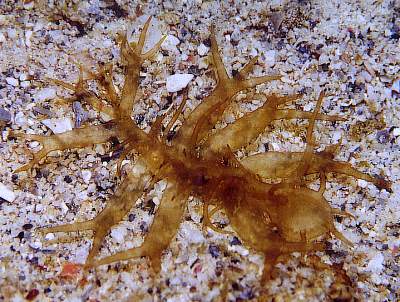
Melibe megaceras
Gosliner, 1987
Order: NUDIBRANCHIA
Suborder: DENDRONOTINA
Family: Tethydidae
DISTRIBUTION
Known from Hawaii, Malaysia, & Great Barrier Reef. Probably widespread at least in tropical Pacific.
PHOTO
Mantanani Is, near Kota Kinabalu, Sabah, Malaysia. In 24m depth [19-24 March, 2003] Photos: Harry Erhardt
The whole animal appears translucent brown, the colour coming from microscopic algae [zooxanthellae] living in the body, and which can be seen through the transparent body wall. Some animals can have opaque whitish spots on the ceratal wall and along the edge of the foot [see photo in separate message].
Like all species of Melibe there is a large oral hood which is used in the capture of its food - small crustacea. There are also large cerata down each side of the body. As its name megaceras implies, the cerata are extremely large, or at least greatly elongated, in this species and at the tip there are two or three long pointed papillae. All over the dorsal surface, the sides of the body, and the oral hood, are long tapering unbranched papillae. [see message 1 and message 2 for close-up photos showing these structures in greater detail]. All species of Melibe are rather strange in shape, but this must be the strangest of all. It reaches at least 70mm in length.
Gosliner (1987) reports that this species is found on shallow water sandflats in Hawaii and suggests that it may be seasonally abundant. He describes how it holds the cerata out horizontally when it is crawling along, so that it is 'exeedingly flat'. It translucent brown colour, and its flat aspect, make it almost invisible on a white sandy bottom. Steve Kempf (1984) found small crustacean remains in its faeces, and fed it brine shrimp in captivity, confirming that it is a feeder on small crustacea. He also observed it swimming by lateral flexion of the whole body. The egg mass is a white coiled ribbon attached to the sand by a mucous thread.
Kempf (1984) studied the symbiotic relationship between Melibe megaceras and its symbiotic zooxanthellae Symbiodinium microadriaticum. This symbiosis appears to be an intermediate step on the way to some of the truly solar-powered symbioses I describe elsewhere in the Forum. We are not sure how M. megaceras obtains its zooxanthellae, as they are not present in the eggs or embryo, and its does not feed on an organism already containing zooxanthellae. Kempf suggests that it must obtain them either during the veliger stage, when it is an phytoplankton feeder, or just after metamorphosis, when it may feed on something which has zooxanthellae. M. megaceras does not appear to be able to 'milk' the living zooxanthellae of their photosynthetic products, and so must regularly kill and partially digest some of its symbiont zooxanthellae to obtain access to the products of algal photosynthesis. I can only assume that the behaviour of holding the cerata out flat when crawling around is a behaviour evolved to favour the symbiotic algae in its cerata and body wall - giving them maximum access to available sunlight.
Reference:
• Gosliner, T.M. (1987) Review of the nudibranch genus Melibe (Opisthobranchia: Dendronotacea) with descriptions of two new species. The Veliger, 29(4): 400-414.
• Kempf, S. C. 1984. Symbiosis between the zooxanthella Symbiodinium (=Gymnodinium) microadriaticum (Freudenthal) and four species of nudibranchs. Biological Bulletin, 166(1): 110-126.
Rudman, W.B., 2003 (April 14) Melibe megaceras Gosliner, 1987. [In] Sea Slug Forum. Australian Museum, Sydney. Available from http://www.seaslugforum.net/factsheet/melimega
Related messages
-
Re: Melibe megaceras from Red Sea
From: Bill Rudman, March 15, 2005 -
Melibe megaceras from the Red Sea
From: Oren Lederman, March 12, 2005 -
Melibe megaceras from the Great Barrier Reef
From: Bill Rudman, May 6, 2003 -
Melibe megaceras from Malaysia
From: Harry Erhardt, April 17, 2003 -
Melibe megaceras - detail of the head
From: Bill Rudman, April 17, 2003 -
Melibe megaceras from Malaysia (2)
From: Harry Erhardt, April 17, 2003 -
Melibe megaceras - anatomical details
From: Bill Rudman, April 17, 2003
